![]()
![]()
![]()
Use LEFT and RIGHT arrow keys to navigate between flashcards;
Use UP and DOWN arrow keys to flip the card;
H to show hint;
A reads text to speech;
58 Cards in this Set
- Front
- Back
- 3rd side (hint)
|
Anatomical position |
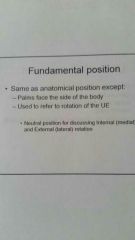
|
|
|
|
Fundamental position |
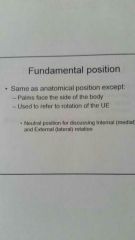
|
|
|
|
Anterior |
To the front |
|
|
|
Posterior |
To the rear, behind. |
|
|
|
Superior |
Abover, towards the head |
|
|
|
Inferior |
Below, towards the feet |
|
|
|
Lateral |
Away from mid-line |
|
|
|
Medial |
Towards the midline |
|
|
|
Distal |
Away from the trunk or center |
|
|
|
Proximal |
Toward the trunk or center |
|
|
|
Superficial |
Closer to the surface or skin |
|
|
|
Deep |
Further from the surface or skin |
|
|
|
What is Kinesiology |
The study of movement |
|
|
|
What is Biomechanics? |
The use of mechanical principles to study the human body. |
|
|
|
What is kinematics? |
The time, space and mass aspects of moving systems. |
|
|
|
In which ways does motion occur? |
Parallel to the planes, around the corresponding axis. |
|
|
|
What 3 planes does motion occur in? |
Frontal (coronal), sagittal, horizontal (transverse) plane |
|
|
|
Frontal plane |
Divides the body into front and back halfs. Motion occurs side tonside. Includes abduction, adduction, and lateral flexion (side bending.) |
|
|
|
Sagittal plane |
Divides body into right and left halfs. Motion occurs forwards and backwards. Includes flexion, extension, and hypertension. |
|
|
|
Horizontal plane |
Divides the body into upper and lower halfs. Motion occurs parallel to the ground. Includes medial rotation, external rotation and cervical and trunk rotation. |
|
|
|
Special cases for planes of movement. |
Radial deviation, ulnar deviation, ankle plantar flexion, ankle dorsiflexion, ankle inversion, ankle eversion, thumb flexion/extension, thumb abduction/adduction, finger abduction/adduction and toe abduction/adduction. |
|
|
|
Rotary (angular) motion |
Takes places around an axis through a curved path. All parts of the object move through the same angle, same direction, at the same time but NOT THE same distance. All joint movement is angular. |
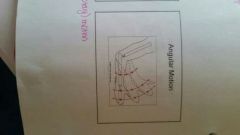
|
|
|
Translatory (linear) motion |
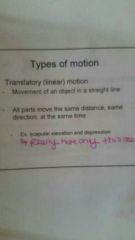
|
|
|
|
Curvilinear motion |
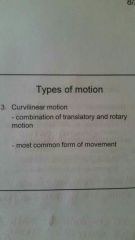
|
|
|
|
Degrees of freedom |

|
|
|
|
Circumduction |
Combination motion occurring around 2 or 3 axes. Example: opposition of thumb to other fingers. Abduction/adduction with flexion/extention at the same time. |
|
|
|
Kinematic chains - closed chain |
Distal segment of the limb is fixed. If one link moves they all move in a predictable pattern. Example: squating, push ups. All joints work collectively. Mostly lower extremities. |
|
|
|
Kinematic chains - open chain |
Distal segment of the limb is not fixed. Segments are free to move individually. Example: wrist flexion, finger flexion, moving knee or ankle when sitting. Mostly upper extremities. |
|
|
|
Hypermobile |
More motion allowed at the joint then normal. |
|
|
|
Hyponormal |
Less motion allowed at a joint then normal. |
|
|
|
Bony end feel |
Hard, abrupt limit to motion. Also known as hard end feel. |
|
|
|
Capsular end feel |
Hard, leather like limitation with slight give. Ex: shoulder motions. |
|
|
|
Empty end feel |
Lack of mechanical limitation. Motion is limited by pain. This us almost never normal. |
|
|
|
Springy block end feel |
Rebound movement at end range usually when there is a torn cartilage. |
|
|
|
Muscle guarding end feel |
Reflex muscle spasm during motion. Protective response seen with acute injury. |
|
|
|
Osteokinematics |
Gross movements of the bony segments. Ex: flexion/extention, abduction/adduction, medial and lateral rotation. This type of joint movement is voluntary. |
Osteo means bone |
|
|
Arthrokinematics |
Relatively small movements that occur between the articular surfaces of the joint. They are not under voluntary control. "Accessory movements" You can't have osteokinematics without arthrokinematics. Types include rolling, spinning, sliding. |
|
|
|
Concave |
Concave means the joint surface moves in the same direction as the osteokinematic motion. |
|
|
|
Convex |
Convex means the joint surface s moving in the opposite direction of the osteokinematic motion. Most often motion is convex |
|
|
|
Basic Biomechanics |
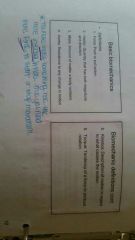
|

|
|
|
Newton's first law of motion -law of inertia |
A force is required to start a motion, to change direction, or to stop a motion. A body at rest wants to stay at rest, a body in motion wants to stay in motion. |
|
|
|
Newton's second law of motion - law or acceleration. |
The acceleration of a body is proportional to the magnitude of the force acting on it and inversely proportional to the mass of the body. Acceleration equals force divided by mass. |
A = F/M |
|
|
Newton's third law of motion - law of action and reaction. |
For every action there is an equal and opposite reaction. Ex: jumping on a tampoline. |
|
|
|
Types of forces. |
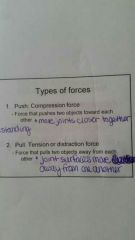
|
|
|
|
Gravity |
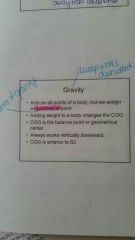
|
|
|
|
Lever |
Simple rigid bar (bone) |
|
|
|
Fulcrum |
Point about which the level rotates. (Joint) "axis" |
|
|
|
Force |
Creates movement (muscle) |
|
|
|
Load |
Resistance (body weight) |
|
|
|
Force arm |
Distance between the fulcrum and point of force application |
|
|
|
Load arm |
Distance between the fulcrum and the point of load application |
|
|
|
First class levers |
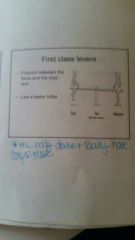
|
|
|
|
Second class lever |
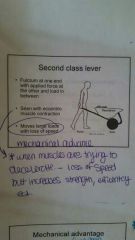
|
|
|
|
Third class lever |
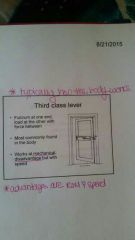
|
|
|
|
Stability |
Low center of gravity, wide base of support, gravity line is centrally located, heavy weight. |
|
|
|
Mobility |
High center of gravity, narrow base of support, gravity line is centrally located and light weight. |
|
|
|
Balance |

|
|
|
|
What is kinetics? |
The force that causes movement. |
|

